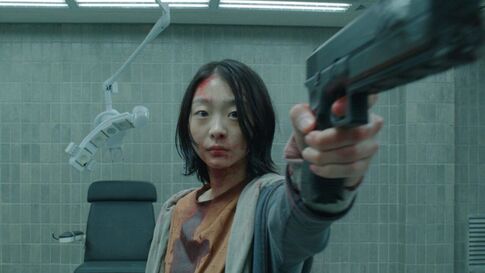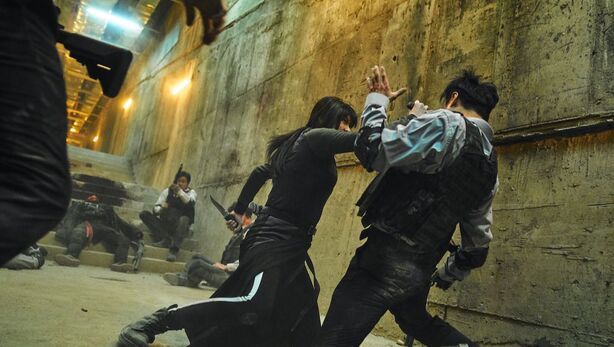 Big Budget South Korean films owe much of their visual aesthetic to American films while offering a wholly unique perspective on class, gender, and family. Films like The Host and Train To Busan look similar to their American counterparts but feel radically different... ...Tragically, the abundantly titled The Witch: Part 1. The Subversion takes some of the worst visual elements of American cinema and adds tired plot elements that create a predictable story. Written and Directed by Park Hoon-jung (New World and I Saw The Devil) and starring the captivating Kim Da-mi, The Witch tells the story of an eminently capable young woman (Koo) who finds her life upended after she appears on a reality TV show. The film is beautifully shot and the film’s dramatic sequences make it clear that Park is a talented director. As a screenwriter, Park seems less skilled. It is possible that the film lost something in translation but the writing issues go beyond word choice. The films many plot points seem to trip over each other as the film rushes to its too long conclusion. The Witch begins with a violent and bloody night in the kind of cemented government building we have seen in hundreds of similar films. Two very serious looking individuals who work for a vague and menacing government research program talk about a child that has escaped. The government workers agree that the child cannot survive outside the building. Neither seems very concerned about the security breach. We see the child, a young girl, running through the woods. The girl finds her way to a small farm and is taken in by the farmer and his wife. The narrative then jumps ahead ten years to when the girl is a young woman of 19ish. This is Koo. Needing money for her family, Koo goes onto the South Korean version of “American Idol.” Soon, people from the government program realize who Koo really is and start chasing her, threatening her family, and just straight up killing people for little reason. The movie lost me very early on by showing the night that Koo escaped the government building. I kept wishing that I had not been shown her backstory as this information more or less eliminated any mystery. Seeing the film through the eyes of a young woman who doesn’t know why she is being pursued or even who is after her would create a dramatic tension that could maintain a viewer’s interest for at least 2 Acts. Because we are shown the backstory immediately, I found myself just waiting for the movie to reveal what I knew it was going to tell me but with a little more information. Koo and her journey are woefully derivative. Movies like Akira, Lucy, and even Firestarter were unintentionally invoked throughout the film. I found myself watching every scene and thinking, “Is Koo going to do the thing that I know she can do now? No? Alright. I’ll keep waiting.” Certain elements of the story are conventions of the genre and largely forgivable. A young runaway being taken in by a kindly farmer and his wife is a classic story point. But the story of a super-powered youngster who does not know the full extent of their abilities is far too close to things we’ve seen far too many times to be interesting. This film is mostly saved by its lush and beautiful cinematography. From urban skyscrapers to bucolic farmland, every frame of The Witch is beautiful. High contrasts give the dark shadows a terrifying quality that suggests the unknown and the feared. The camera drifts through shots with an ethereal quality that tells us a slow and creeping death is on its way. Visually, the film is powerfully shot, saving even the most uninteresting scenes. Unfortunately, this film does not hold up as well during its many action sequences. The action is competently shot and edited, we always know exactly what is happening and the geography is clear, so there’s that. The problem with the action sequences is that what starts as a seemingly grounded story abruptly goes off the rails whenever violence is introduced. During the film’s too long finale, characters are replaced with good (but not great) CGI doubles that bend and twist like cartoons. The tension that was building throughout the film becomes comically deflated by the poor visual effects. Indeed, the last act of the film suffers greatly from too much ambition. In the moments where The Witch does not focus on action or exploring the mystery that viewers already have the answer to, it touches on the subject of adopted families. Koo, as far as we know, has no idea as to the identity of her real parents. As the story progresses, Koo must decide which family she wants to belong to. Should Koo stay with the farmer and his wife, Koo would be deciding to be as in the dark about her lineage as anybody else in her new life. If Koo searches out her origin, she will be walking into the past and the dangerous arms of her former adopted parents. It’s an interesting dilemma she is faced with. An additional scene where Koo struggles with this decision would have deepened her character and put the audience more into her mindset. This is not how the film plays out, however. Koo’s decision is made rather quickly and with little reason given until the very end of the film. In any high concept film, there is a fine line between over explaining and under explaining. Too much explanations result in a film that feels like a live reading of a Wikipedia page; not enough and you’ve got a theatre full of people scratching their heads and wondering if anything actually happened. The Witch rarely strikes that balance. Koo’s childhood, for example, is shown, told, and shown again throughout the movie. Add to these redundancies the thought that any audience who has seen this type of movie already knows where we’re going and the film ends up quite boring at times. Scenes play out where a viewer will whisper with exasperation, “I know…” Conversely, characters who would benefit from clear motivation (or even names) aren’t given any. The reasoning behind this discrepancy eludes me. The Witch strives to bring new life to a tired concept and succeeds in some ways while coming up short in others. The title promises a sequel. Sources suggest that this is part one of a proposed trilogy and part 2 is already in production. While the ending did not leave me desperately waiting for a continuation, the talent behind and in front of the camera does make me want to see more from this team. Perhaps Park Hoon-jung has bigger plans for the next film in the series. I only hope that he brings on a writing partner and maybe a different visual effects team. By Mark Gonzales
0 Comments
Leave a Reply. |
Archives
March 2023
|


 RSS Feed
RSS Feed